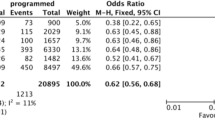Abstract
Purpose
Whether differences in stimulation parameters alter the number and proportion of MII oocytes retrieved.
Methods
Records of 2546 patients were examined, looking at age, day 2/3 follicle-stimulating hormone (FSH) and estradiol (E2) levels, total dose of gonadotropins administered (including FSH and human menopausal gonadotropin [hMG]), fraction of hMG administered, number of days of treatment with gonadotropins, and the dose of gonadotropins administered per day. We segregated the patients into 3 different classes depending on the trigger method used and 2 groups based on egg freeze vs. ICSI. Multiple regression methods were used to examine associations between stimulation parameters and the total number of eggs, number of immature oocytes (Poisson regression), and the fraction of retrieved oocytes that were immature (Logistic regression).
Results
After adjustments for different triggers and egg freeze versus ICSI, both the #immature oocytes and the immature fraction of oocytes were associated with the total gonadotropin dose (inversely) and the gonadotropin dose/day (positively). Other parameters were associated with the number of immature oocytes but were also associated with the number of oocytes retrieved.
Conclusions
Stimulations using less total gonadotropin and more gonadotropin per day were associated with more immaturity. The type of trigger method used for final maturation was associated with immaturity but was believed to be predominantly due to trigger assignment to patients based on response. The association between use of ICSI and less immaturity was believed to be due to additional time for maturation in the ICSI group.
Similar content being viewed by others
References
Beall S, Brenner C, Segars J. Oocyte maturation failure: a syndrome of bad eggs. Fertil Steril. 2010;94(7):2507–13. https://doi.org/10.1016/j.fertnstert.2010.02.037.
Practice Committees of the American Society for Reproductive Medicine, the Society of Reproductive Biologists and Technologists, and the Society for Assisted Reproductive Technology. Electronic address: jgoldstein@asrm.org. In vitro maturation: a committee opinion. Fertil Steril. 2021;115(2):298–304. https://doi.org/10.1016/j.fertnstert.2020.11.018.
Brown HM, Dunning KR, Sutton-McDowall M, Gilchrist RB, Thompson JG, Russell DL. Failure to launch: aberrant cumulus gene expression during oocyte in vitro maturation. Reproduction. 2017;153(3):R109–20. https://doi.org/10.1530/REP-16-0426.
Check JH. Mild ovarian stimulation. J Assist Reprod Genet. 2007;24(12):621–7. https://doi.org/10.1007/s10815-007-9179-9.
Lonergan P, Fair T. Maturation of Oocytes in Vitro. Annu Rev Anim Biosci. 2016;4:255–68. https://doi.org/10.1146/annurev-animal-022114-110822.
Witz CA, Daftary GS, Doody KJ, Park JK, Seifu Y, Yankov VI, et al. Menopur in GnRH antagonist cycles with single embryo transfer – high responder (MEGASET-HR) trial group. Randomized, assessor-blinded trial comparing highly purified human menotropin and recombinant follicle-stimulating hormone in high responders undergoing intracytoplasmic sperm injection. Fertil Steril. 2020;114(2):321–30. https://doi.org/10.1016/j.fertnstert.2020.03.029.
Devroey P, Pellicer A, Nyboe Andersen A. Arce JC; Menopur in GnRH Antagonist Cycles with Single Embryo Transfer Trial Group. A randomized assessor-blind trial comparing highly purified hMG and recombinant FSH in a GnRH antagonist cycle with compulsory single-blastocyst transfer. Fertil Steril. 2012;97(3):561–71. https://doi.org/10.1016/j.fertnstert.2011.12.016.
Arce JC, Klein BM, La Marca A. The rate of high ovarian response in women identified at risk by a high serum AMH level is influenced by the type of gonadotropin. Gynecol Endocrinol. 2014;30(6):444–50. https://doi.org/10.3109/09513590.2014.892066.
Andersen AN, Devroey P, Arce JC. Clinical outcome following stimulation with highly purified hMG or recombinant FSH in patients undergoing IVF: a randomized assessor-blind controlled trial. Hum Reprod. 2006;21(12):3217–27. https://doi.org/10.1093/humrep/del284.
Lin Y, Yang P, Chen Y, Zhu J, Zhang X, Ma C. Factors inducing decreased oocyte maturation rate: a retrospective analysis of 20,939 ICSI cycles. Arch Gynecol Obstet. 2019 Feb;299(2):559–64. https://doi.org/10.1007/s00404-018-4958-3.
Author information
Authors and Affiliations
Corresponding author
Additional information
Publisher’s note
Springer Nature remains neutral with regard to jurisdictional claims in published maps and institutional affiliations.
Rights and permissions
About this article
Cite this article
Gonullu, D.C., McCulloh, D.H., Robinson, L.G. et al. Oocyte stimulation parameters influence the number and proportion of mature oocytes retrieved in assisted reproductive technology cycles. J Assist Reprod Genet 38, 2283–2289 (2021). https://doi.org/10.1007/s10815-021-02220-2
Received:
Accepted:
Published:
Issue Date:
DOI: https://doi.org/10.1007/s10815-021-02220-2




